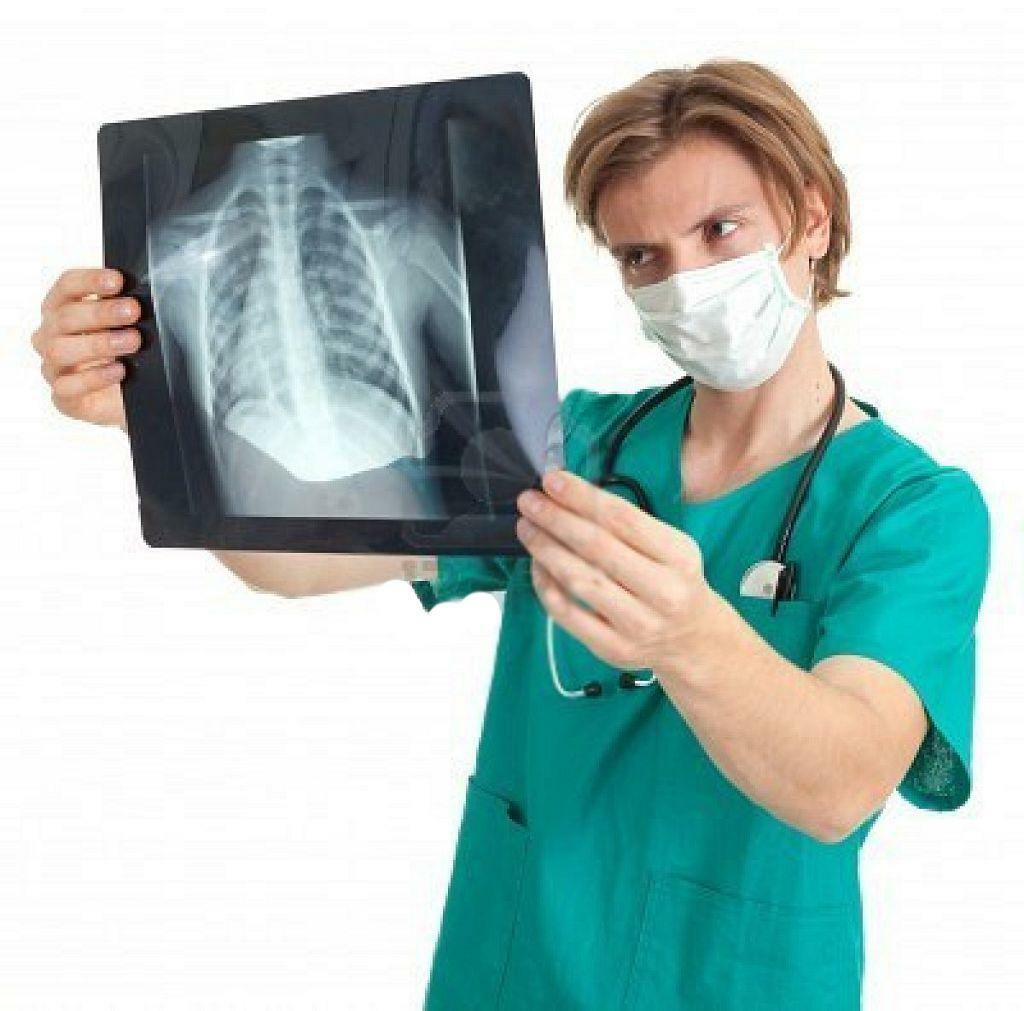Sometimes, under the influence of external factors, a person can damage the main axis of his body - the spine. As a result, the intervertebral disc is destroyed. To treat this phenomenon, an urgent operation is required to remove the hernia. Complications after such an operation are determined by the limited movement of the patient. Consequently, in order to return to the normal course of life, competent rehabilitation is required.

rehabilitation after an operation for the removal of intervertebral hernia
Content of material
- 1 What are the aims of rehabilitation procedures?
- 2 Basic principles of rehabilitation procedures
- 3 How many stages of rehabilitation?
- 4 What are the limitations?
- 5 Performing post-operative action
- 5.1 Video - Rehabilitation after removal of hernias
- 6 Necessary physiotherapy action
- 7 Temperature
- therapy 7.1 Paraffin applications
- 7.2 exposure to cold
- 8 Application key core exercises
- 9 benefits of therapeutic baths
- 10 Restorative water
- 11 procedures Physiotherapy
- 11.1 Exercise1
- 11.2 Activity 2
- 11.3 Activity 3
- 11.4 Activity 4
- 11.5 Vieweo - Gymnastics for the back, after surgery
- 12 How does dietotherapy help?
What are the aims of rehabilitation procedures?
When the removal of the intervertebral hernia, it is impossible to count on the final result and recovery. In spite of the fact that all the surgical actions of the treatment are performed, the patient may have additional symptoms, manifested as a pain and neurologic syndrome. In some cases, the patient may suffer from loss of sensitivity. The explanation for this is simple - a long period of hernia made pressure on the vertebral nerves, resulting in the development of a tumor, as well as irritation, which remains even after surgery.
Based on this, a competent rehabilitation program is required, which consists of the following objectives:
- Normalization of the general condition of the patient and getting rid of any restrictions.
- Restore health in general.
- Elimination of restrictions that prohibit physical activity.
- Getting rid of the pain syndrome.
- Neutralization of neurological symptoms.

Only specialist
should determine the direction of rehabilitation procedures. Therefore, it is up to the expert to determine the direction of rehabilitation procedures, which takes into account all the side factors. In general, the duration of rehabilitation can take almost twelve months. The general complex of rehabilitation therapy measures includes medical treatment, stay of a patient in a sanatorium, physiotherapy, and the use of therapeutic gymnastics.
Basic principles of rehabilitation procedures
One of the main things is the correct organization of the rehabilitation period, after which the following principles should be implemented:
- All rehabilitation procedures should be selected taking into account the individual characteristics of the patient.
- The patient during rehabilitation should be under the watchful control of three specialists( surgeon, rehabilitologist and neurologist).
Thus, all the rehabilitative procedures pursued pursue two main goals: to restore a person's ability to work after a surgery in the shortest possible time and to become a preventive measure for the emergence of new hernial formations.
Rehabilitation measures are carried out taking into account the main factors that directly affect the effectiveness of rehabilitation:
- Age indicators of the patient.
- Possible additional ailments.
- Type of surgical treatment performed.
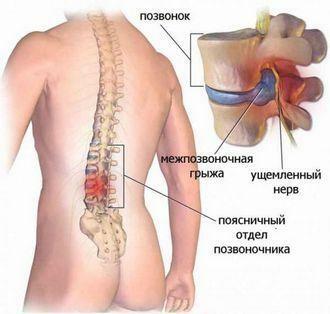
Intervertebral hernia
How many stages of rehabilitation?
The general rehabilitation course can be divided into three separate stages.
| Stage | Description |
|---|---|
| Early | Its duration is determined by two weeks. The basis of the course is psychotherapeutic support. In parallel, manipulations to eliminate the pain syndrome |
| are included. Late | This recovery phase can take eight weeks. All actions are aimed at adapting the patient to life in the habitual life of the |
| . Delayed | . It is worth considering that the removal of the pathology may require a long recovery, which lasts for the rest of his life. Basically, such rehabilitation measures should start on the fourth month of |
. What are the limitations?
The early rehabilitation stage will bring results if you initially adhere to all restrictions on active actions:
- You can not start any physical actions without using a corset.
- Do not lift weights.
- The use of massage techniques, manual therapy is excluded.
- No walking on a bicycle and a similar vehicle.
- Prohibition of active sports games.
- Seated position restraint.
- No sharp, twisting or deep movements in the operated spine.

Lumbar corset after spine operation
Restrictions relating to late recovery:
- Riding in any vehicle for more than one hour.
- Spine load without the use of preliminary workouts.
- Subcooling of back muscles.
- The use of the corset is unnecessary.
- Lifting a load that exceeds the weight of eight kilograms.
- Stay long in one position.
Please note! The main principle that a patient should adhere to after surgical treatment is the exclusion of all kinds of heavy loads and the protection of the sore spot from any adverse effects( it is especially dangerous to chill).
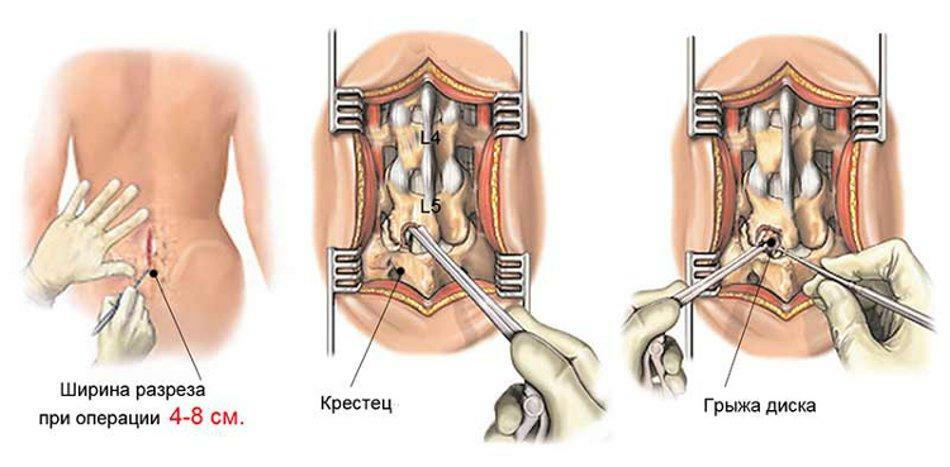
Procedure for the removal of a hernia on the spine
Performing postoperative actions
Restorative manipulations in the postoperative period should include the following actions:
- Inclusion of a patient in the exercise program.
- Prescriptions for sanitary therapy.
- Application of procedures that stimulate blood circulation and anesthetize( laser therapy).
- Carrying out hydroprocedures( produced as mechanical loads).
- Cure inflammation.
- Application of kinesitherapy.
- Therapeutic manipulations with the help of certain medications to reduce the inflammatory process in the bone tissue.
Video - Rehabilitation after removal of hernia
Required physiotherapy
After the herniation in the intervertebral area is removed, a set of physiotherapeutic measures is prescribed:
| Physiotherapy measure | Description |
|---|---|
| Mud pack | It is used after an operation to get rid of inflammation, and also for anesthetic effect |
| Electrostimulation | This manipulation is interstitial and is performed to renew nerve endings that have suffered from a hernia. In addition, the procedure provides active replenishment of bone tissue |
| Ultrasonic manipulation | Used to nourish and stimulate the growth of tissue cells |
| Magnetotherapy | Due to manipulation, puffiness, pain, inflammation is eliminated. In addition, this effect contributes to the normalization of metabolic processes |
| EHF | The procedure is deciphered, as extreme high-frequency therapy. It is widely used to quickly restore muscle tone. Additionally, it normalizes blood circulation. As a result, the procedure helps to eliminate pain and possible edema. |
| Ionophoresis | This manipulation is used to maximize the penetration of the medication through the skin. The main task is to remove the pain syndrome |
| Phonophoresis | To eliminate the pain syndrome and the formed edema use phonophoresis. Thus, by means of ultrasound, the drug |
is inserted. Attention! All postoperative rehabilitation programs are made by the leading doctor, taking into account all the individual characteristics of the patient. Self-treatment is strictly prohibited!
Temperature therapy
Strangely enough, but rehabilitative manipulations after the removal of the intervertebral hernia consist of exposure to temperature on the operated site.
Paraffin applications
This is one of the main manipulations that is carried out to improve lymph circulation, normalize blood flow, eliminate inflammation, to activate nerve impulses, to eliminate possible muscle spasms.
Caution, contraindications! The use of this procedure is not allowed for all patients. There are a number of limitations( cirrhosis, the presence of tumor formations, tuberculosis).It is also forbidden to apply paraffin applications in cases of hypertension.

The benefits of paraffin treatment
Effects of cold
According to the specialist, the cold can be applied immediately after the surgical procedures. Thanks to ice, you can reduce pain syndrome, eliminate the degree of inflammation and get rid of muscle spasm. Thus, the blood vessels narrow and the blood flow decreases significantly.
Application of key basic exercises
Patients on the first postoperative days are recommended to perform therapeutic exercises:
- Lower limbs slowly bend and unbend at the knees.
- Then follow the circular movements of the limbs.
- Raise and lower the feet.
- Gradual pulling the knees( while lying in the supine position) to the stomach with the subsequent straightening.
Warning! Key exercises in the postoperative period are necessary and very effective, but only increase the load moderately and gradually so that the spine is not overloaded.
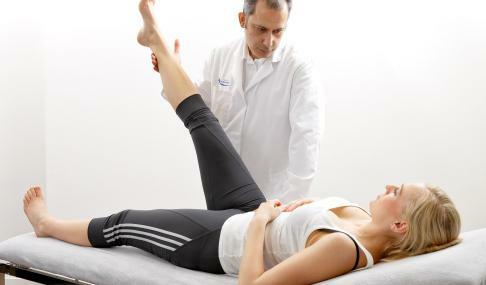
Therapeutic gymnastics in the first days after the operation
The benefits of therapeutic baths
The most popular way to restore the functionality of the spine after the operation is carried out is the use of special baths.
| Type of bath | Description |
|---|---|
| Radon | Used to restore nerve conduction and improve blood circulation |
| Turpentine | Promote rapid resorption of adhesions |
| Herbal | Eliminate pain and help muscles relax |
| Hydrogen sulfide | Also often used in parallel are sulphide baths. The main impact is in the resorption processes of inflammation, stimulation of blood circulation, the restoration of damaged tissues, the promotion of muscle contractions. |
. Restorative water procedures.
. The patient, while in the water, feels the maximum relaxation not only of muscles, but also moral( very important in the postoperative period).
Please note! Long-term water procedures are contraindicated after removal of a hernia in the intervertebral disc. Therefore, the duration of the whirlpool procedure should not exceed more than thirty minutes. The satisfactory time is fifteen minutes.
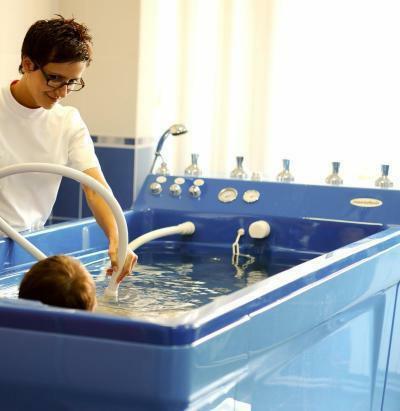
Optimum time for water procedures after removal of the intervertebral hernia - 15 minutes
To restore nerve endings and sensitivity, experts recommend using douche. As a result, there will be stimulation of muscle activity. For maximum benefit, it is best to do a short douche.
Therapeutic gymnastics
In general, all medical exercises should be selected by a doctor on an individual approach to the patient. But, in addition there is a set of general recommendations that help strengthen the spine and prepare it for everyday routine loads.
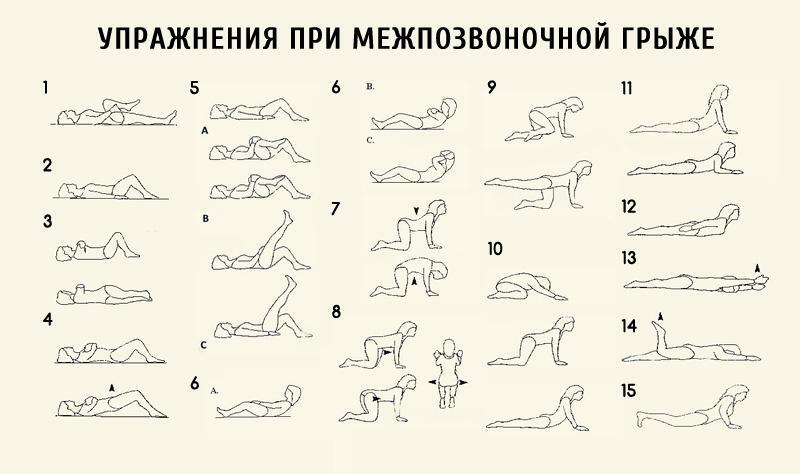
Exercises for the intervertebral hernia
Exercise 1
The patient lies on his back, trying to bend the limbs in the knees, starting to spread his arms to the sides. Then the pelvis lifts slightly( there should be no acute pain) and tries to stay in this position for ten seconds. With each training, the duration of the pelvic retention should increase and eventually reach one minute.
Exercise 2
The patient again lies on his back and crosses his arms over his chest, legs are again bent at the knees. Next, you should press your chin to your chest. Then, straining with all the strength of the abdominal muscles, make attempts to raise the torso, delaying ten seconds in this position. At the end of time, the body comes to the original relaxing position. The approach consists of ten repetitions, which each time should increase.
Exercise 3
The third exercise should also be performed in a recumbent position. Further bent limbs in the knees, slowly, pressed against the chest. In this case, the patient should feel the tension in the muscles of the buttocks. After that, the gluteal muscles relax, but the legs remain bent for about forty seconds. At the end of time, the lower extremities slowly straighten without sudden movements.
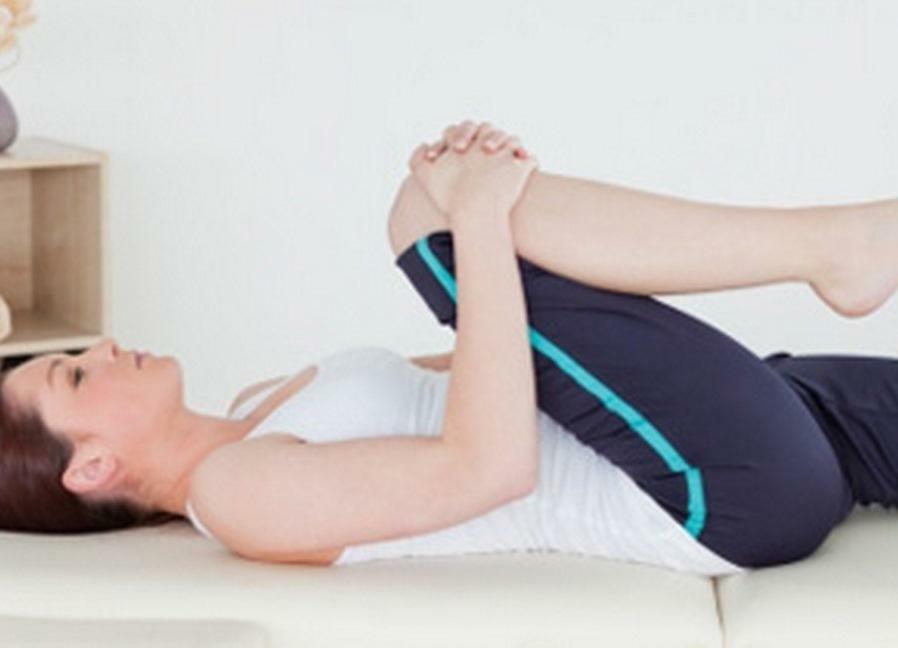
Pulling the knee to the chest
Exercise 4
The person becomes in a position on all fours. Then, simultaneously, he tries to make a cross movement, pulling the lower and upper limb, that is, with his left arm, the right leg is extended. Then we change. Keep in this position should be up to ten seconds, increasing the time to one minute.
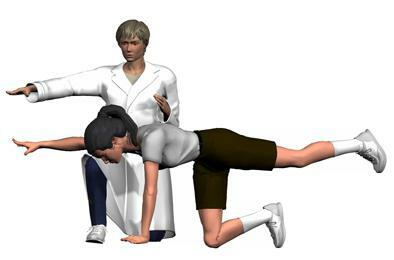
Correct execution of exercise number 4
Video - Back gym, after surgery
How does dietotherapy help?
The first question that arises on this basis, how can a diet help restore the spine? It's very simple: right after the operation a person should consume exclusively digestible food saturated with a huge amount of fiber. That is, in the first days of the patient it is recommended to eat only vegetables and gruel. If you do not adhere to this rule, you expect a swelling or a problem with the calves, which leads to an overload of the abdominal muscles.
Further diet after removal of the intervertebral hernia should consist exclusively of low-calorie foods. In the postoperative period it is undesirable to gain additional weight - this can complicate the recovery of the body. In addition, extra pounds will heavily burden the damaged spine.

List of low-calorie products
Recommendations! In the first months after the operation, it is best to compose a dietary diet from low-calorie, but fiber-rich foods. Drink juices and fruit drinks, exclude salt intake.
In conclusion, it should be noted that rehabilitation requires a long and hard work on the part of the patient. And only the desire of the patient himself will help to return to the habitual rhythm of vital activity as soon as possible.

